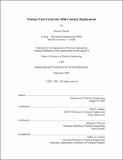| dc.contributor.advisor | Neil E. Todreas. | en_US |
| dc.contributor.author | Parent, Etienne, 1977- | en_US |
| dc.contributor.other | Massachusetts Institute of Technology. Dept. of Nuclear Engineering. | en_US |
| dc.date.accessioned | 2005-05-19T15:42:57Z | |
| dc.date.available | 2005-05-19T15:42:57Z | |
| dc.date.copyright | 2003 | en_US |
| dc.date.issued | 2003 | en_US |
| dc.identifier.uri | http://hdl.handle.net/1721.1/17027 | |
| dc.description | Thesis (S.M.)--Massachusetts Institute of Technology, Dept. of Nuclear Engineering, 2003. | en_US |
| dc.description | Includes bibliographical references. | en_US |
| dc.description | This electronic version was submitted by the student author. The certified thesis is available in the Institute Archives and Special Collections. | en_US |
| dc.description.abstract | A comparative analysis of nuclear fuel cycles was carried out. Fuel cycles reviewed include: once-through fuel cycles in LWRs, PHWRs, HTGRs, and fast gas cooled breed and burn reactors; single-pass recycle schemes: plutonium recycle in LWRs and direct-use of spent PWR fuel in CANDU reactors (DUPIC); multi-pass recycle schemes: transmutation of transuranics in LWRs, fast reactors, double strata systems, and molten salt reactors. Mass flow calculations for the fuel cycles at equilibrium were carried out based on data available in the open literature, and results were used to compare the performance of the fuel cycles with respect to uranium utilization, waste management, proliferation resistance, and economics. Potential for mid-century deployment was assessed based on these results. Once-through fuel cycles based on solid fuel thermal reactors are found to be the best candidates for mid-century deployment because the substantial increase in electricity costs entailed by reprocessing schemes is unlikely to be justified by the afforded reductions in long-term proliferation and waste management risks. Furthermore, once-through cycles present lower proliferation and waste management risks in the short-term and their inefficient use of uranium is not likely to become an important issue before the middle of the century even under a high growth scenario. | en_US |
| dc.description.statementofresponsibility | by Etienne Parent. | en_US |
| dc.format.extent | 118 leaves | en_US |
| dc.format.extent | 1393468 bytes | |
| dc.format.extent | 2350602 bytes | |
| dc.format.mimetype | application/pdf | |
| dc.format.mimetype | application/pdf | |
| dc.language.iso | eng | en_US |
| dc.publisher | Massachusetts Institute of Technology | en_US |
| dc.rights | M.I.T. theses are protected by copyright. They may be viewed from this source for any purpose, but reproduction or distribution in any format is prohibited without written permission. See provided URL for inquiries about permission. | en_US |
| dc.rights.uri | http://dspace.mit.edu/handle/1721.1/7582 | |
| dc.subject | Nuclear Engineering. | en_US |
| dc.title | Nuclear fuel cycles for mid-century development | en_US |
| dc.type | Thesis | en_US |
| dc.description.degree | S.M. | en_US |
| dc.contributor.department | Massachusetts Institute of Technology. Department of Nuclear Engineering | en_US |
| dc.contributor.department | Massachusetts Institute of Technology. Department of Nuclear Science and Engineering | |
| dc.identifier.oclc | 54495851 | en_US |
